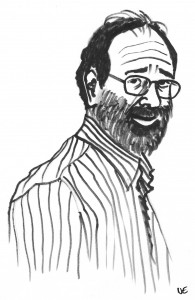Al Roth Takes Home the Nobel Prize

(Illustrator: Niklas Elmehed, Copyright: Nobel Media AB)
Hearty congratulations to Harvard economist Al Roth (now at Stanford), whose work has been featured on many occasions here at the Freakonomics blog!
When I talk about economists, one of the greatest compliments I give is to say that they changed the way people think about the world. Al Roth definitely fits into that category. The type of economics he is best known for is what is called “Market Design.” Essentially, it means bringing market-type thinking to areas in which historically non-market allocation mechanisms have been used. A few examples of the areas Roth has explored are matching fledgling doctors to hospitals for their residency, matching students to public schools in school choice programs, and matching kidney donors with those who need a kidney.
I know Roth changed my thinking because the first time I read Roth’s work in this area I had a strong reaction: this isn’t really economics. His applications, while based on general theories and principles, involve solutions that are highly dependent on the particular institutions and quirks of the setting he is studying. In my youth, I was under the illusion that economic principles should be universal. It was in part through my appreciation of Roth’s work, that I came to think very differently about the world and appreciate how critical it is to think about the specifics of the setting when coming up with solutions. Now, when I read Roth’s work, it definitely feels to me like economics.
An example that we’ve written about here at the blog is Roth’s work on kidney transplants. As much as economists think we should just have a market for kidneys, the rest of the world hasn’t quite caught up to that idea. So Roth came up with a different scheme – one that involves barter — that takes into account the real-world constraints that people aren’t allowed to pay for kidneys. So instead he developed a clearinghouse for connecting chains of pairs in which there is both a person who needs a kidney transplant and a person willing to give one, but who is not a good match medically to donate to his or her loved one. The key is that the potential donor is a good match for someone, just not for the loved one. But, if you can make a chain in which it all balances out: each donor matches with someone willing to donate, then it works out for everyone.
If you want to read more about Roth and his work, we’ve featured him most recently here, and you can find all the past links here.

Comments